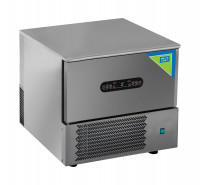The Cook & Chill or Cook & Freeze production process allows the cooking and freezing processes to be separated, enabling special customer requirements to be met and a continuous production process. The food components are first cooked conventionally and then cooled very quickly in the blast chiller or blast freezer to a core temperature of +4 to +2 °C (Cook & Chill) or -18 °C (Cook & Freeze). Cook & Chill: Offers an alternative to fresh cooking. In the Cook & Chill process, the hot food components are prepared and cooked in the conventional way, but then cooled to a temperature below 3 °C within 90 minutes. The chilled food can be stored for up to five days without any loss of quality if the cold chain is uninterrupted. Cook & Freeze: This technology is recommended if food is to be stored at a temperature of -18°/-20 °C. During shock freezing, the liquid part of the products turns into microcrystals that do not damage the tissue structure. When thawing or reprocessing, the unchanged quality of the product can be determined. In the conventional freezing process, the formation of macrocrystals damages the tissue structure of the product and leads to a considerable reduction in quality.
The Cook & Chill or Cook & Freeze production process allows the cooking and freezing processes to be separated, enabling special customer requirements to be met and a continuous...
mehr erfahren »
Fenster schließen
MAYWAY-Blast Freezer
The Cook & Chill or Cook & Freeze production process allows the cooking and freezing processes to be separated, enabling special customer requirements to be met and a continuous production process. The food components are first cooked conventionally and then cooled very quickly in the blast chiller or blast freezer to a core temperature of +4 to +2 °C (Cook & Chill) or -18 °C (Cook & Freeze). Cook & Chill: Offers an alternative to fresh cooking. In the Cook & Chill process, the hot food components are prepared and cooked in the conventional way, but then cooled to a temperature below 3 °C within 90 minutes. The chilled food can be stored for up to five days without any loss of quality if the cold chain is uninterrupted. Cook & Freeze: This technology is recommended if food is to be stored at a temperature of -18°/-20 °C. During shock freezing, the liquid part of the products turns into microcrystals that do not damage the tissue structure. When thawing or reprocessing, the unchanged quality of the product can be determined. In the conventional freezing process, the formation of macrocrystals damages the tissue structure of the product and leads to a considerable reduction in quality.







